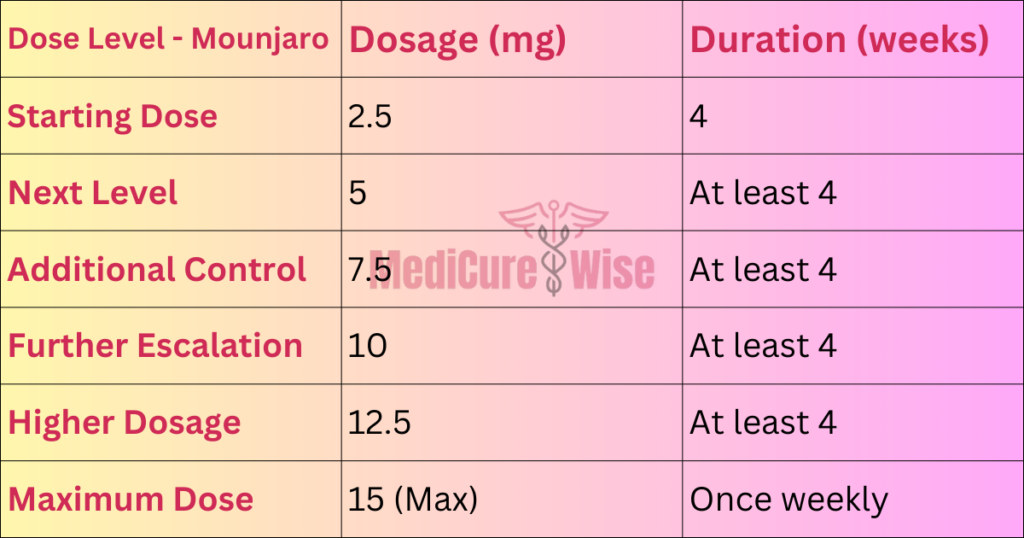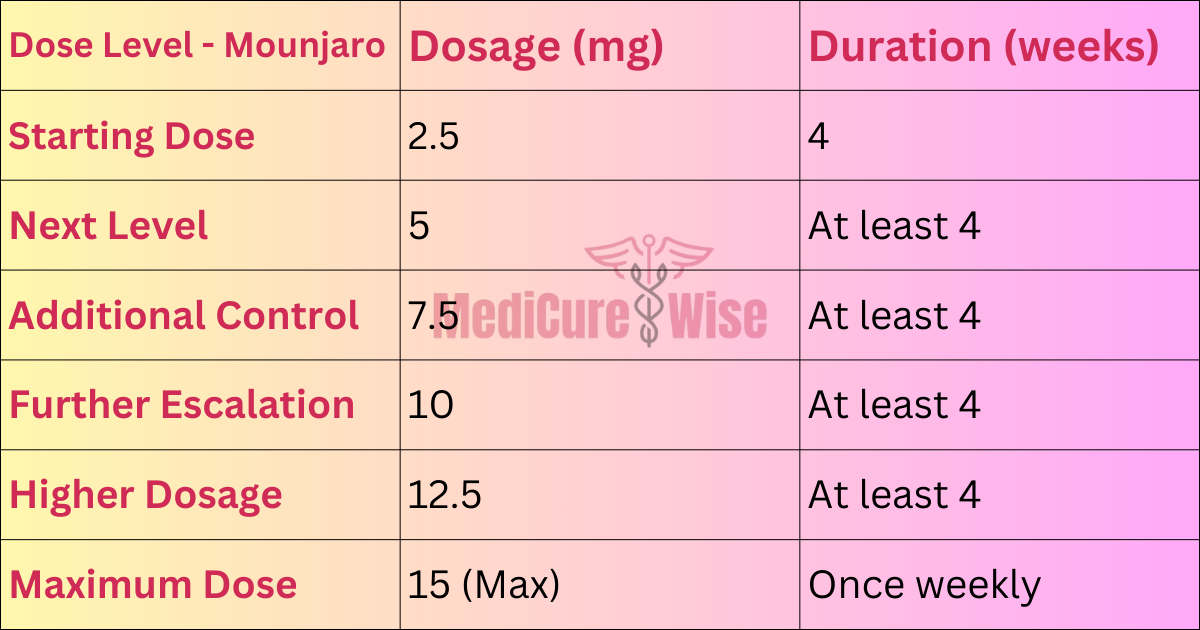Mounjaro’s dosage plan begins at 2.5 mg weekly, progressively reaching a maximum of 15 mg for personalized weight loss, with adjustments based on individual needs.
| Dose Level – Mounjaro | Dosage (mg) | Duration (weeks) |
|---|---|---|
| Starting Dose | 2.5 | 4 |
| Next Level | 5 | At least 4 |
| Additional Control | 7.5 | At least 4 |
| Further Escalation | 10 | At least 4 |
| Higher Dosage | 12.5 | At least 4 |
| Maximum Dose | 15 (Max) | Once weekly |
This table summarizes the Mounjaro dosage escalation, indicating the dose level, the corresponding dosage in milligrams, and the recommended duration in weeks.
If you were recently on Ozempic and are considering a switch to Mounjaro, my previous blog post on the ozempic to mounjaro conversion chart provides essential insights.
Introduction – Mounjaro Dosage Chart
Mounjaro, also known as tirzepatide, is a medication used in the management of type 2 diabetes. It comes in the form of a subcutaneous injection and is available in various strengths, including 2.5mg, 5mg, 7.5mg, 10mg, 12.5mg, and 15mg per 0.5mL. The treatment involves a gradual dose escalation to achieve optimal glycemic control.
Importance of proper dosage and administration
Ensuring the correct dosage and administration of Mounjaro is crucial for its effectiveness and patient safety. The initial dose is typically 2.5mg once weekly for the first 4 weeks, followed by an increase to 5mg once weekly for at least another 4 weeks. The maximum recommended dosage is 15mg injected subcutaneously once weekly.

References for above Mounjaro Dosage Chart. Here
Getting Started with Mounjaro – For Healthcare Professionals ONLY
How to initiate Mounjaro treatment
1. Prescribing process
a. Using the Mounjaro Self-Service Portal
Healthcare providers can initiate Mounjaro treatment by utilizing the Mounjaro Self-Service Portal. This portal likely streamlines the prescription process, making it more accessible and efficient.
b. EHR System integration
Electronic Health Record (EHR) system integration is another avenue for prescribing Mounjaro. Integrating with EHR systems ensures seamless communication between healthcare providers, facilitating a smoother prescription process.
2. Patient engagement
a. Setting expectations
Establishing clear expectations is crucial for patients starting Mounjaro. Healthcare providers should communicate potential side effects, benefits, and the gradual escalation of dosage for optimal results.
b. Providing additional information for a good start
Offering patients additional resources and information about Mounjaro can contribute to a positive start. This may include educational materials, pamphlets, or online resources to enhance patient understanding.
c. Instructional video on taking Mounjaro
“Ozempic, Trulicity, Mounjaro: The Best Time To Take For Best Results!”
Dr. Ergin provides valuable insights on optimizing diabetes medication timing, greatly benefiting our understanding.
3. Safety Information
a. Warning on the risk of thyroid C-cell tumors
Healthcare providers must inform patients about the potential risk of thyroid C-cell tumors associated with Mounjaro.
b. Other safety considerations (Pancreatitis, Hypoglycemia, etc.)
Safety considerations, including pancreatitis and hypoglycemia, should be communicated to patients to ensure vigilant monitoring and early detection of adverse effects.
For more information about prescription: HERE.
III. Dosage Guidelines
A. Customizable glycemic control
1. Multiple doses for customizable glycemic control
Mounjaro offers flexibility with multiple doses for customizable glycemic control. The initial dose is 2.5 mg once weekly for the first 4 weeks, followed by an increase to 5 mg once weekly for at least 4 weeks.
2. Month-wise dosage adjustments
Dosage adjustments occur month-wise to optimize glycemic control:
Month 1: Initiate with a low dose of 2.5 mg/week subcutaneously and gradually escalate.
Month 2: After 4 weeks, increase the dosage to 5 mg/week subcutaneously.
B. Dosage for Adults
1. Typical dosage for adults
- The typical recommended dosage for adults is 2.5 mg per week for the first 4 weeks, followed by an increase to 5 mg per week for at least another 4 weeks.
2. Dosage adjustments for medical conditions or interactions
- Healthcare providers may adjust the dosage based on individual patient needs, considering medical conditions and potential drug interactions.
3. Missed doses and injection day changes
- If a dose is missed, it should be taken as soon as possible within 4 days (96 hours) after the missed dose. If more than 4 days have passed, the missed dose should be skipped.
4. Overdose precautions
- In the event of overdose, appropriate supportive treatment should be initiated according to the patient’s clinical signs and symptoms.
IV. GoodRx Guide for Mounjaro
A. Cost-saving options
1. Utilizing GoodRx for savings
GoodRx provides cost-saving options for Mounjaro. Patients can use the platform to compare prices, find discounts, and access coupons for significant savings on medication costs.
2. Alternative medications and their costs
GoodRx offers information on alternative medications for Mounjaro along with their respective costs. This allows patients to explore cost-effective alternatives based on their healthcare needs.
B. Practical considerations
1. Storage guidelines for Mounjaro
Proper storage is crucial for medication effectiveness. Patients can refer to general storage guidelines to ensure Mounjaro is stored appropriately, maintaining its efficacy.
2. Injection practices, including food considerations
Safe injection practices are emphasized to ensure the effectiveness of Mounjaro. Patients are advised on proper injection techniques, including considerations related to food intake to optimize medication absorption.
V. Conclusion
In conclusion, Mounjaro, or tirzepatide, provides a customizable approach to glycemic control through a carefully structured dosage regimen. The initiation involves multiple doses for customizable glycemic control, with month-wise adjustments ensuring optimal effectiveness. The typical dosage for adults, starting at 2.5 mg and escalating to 5 mg weekly, is tailored for individual patient needs. Dosage adjustments consider medical conditions and interactions, offering a personalized treatment approach.
Healthcare providers are encouraged to responsibly prescribe Mounjaro using tools like the Self-Service Portal and EHR integration. Monitoring side effects and providing overdose precautions ensure safe and efficient usage.
Patient education is paramount. Clear expectations, additional information, and instructional videos enhance understanding. Healthcare providers play a vital role in educating patients about safety considerations, fostering collaboration for successful diabetes management.

